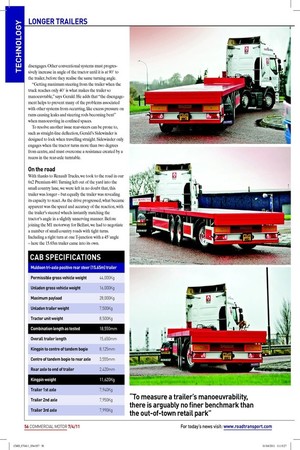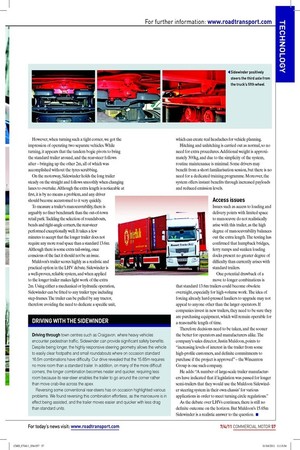Gone with the
Page 42

Page 43

Page 44

Page 45

If you've noticed an error in this article please click here to report it so we can fix it.
CM visits the heart of Muldoon Trailers, to experience its 15.65m trailer and try out its latest rear-steer system – the Sidewinder
Words: Paul White / Images: Alisdair Cusick and Paul White
The quiet country lanes around Dungannon Co. Tyrone, Northern Ireland, are not where you would expect to ind a large semi-trailer manufacturing facility. However, this is the location of Muldoon Trailers, which has been building trailers here for more than 30 years. Throughout that time, Muldoon has designed and manufactured bespoke trailers, from curtainsiders to bulk blowers, and tipping trailers to milk tanks.
A passion for engineering and innovation is evident throughout this family-run business, and the company’s capacity to create novel solutions for individual customers is no doubt one reason for its success. This innovation has led the company’s MD, Gerald Muldoon, to develop and patent the Sidewinder positive rear-steer system. The irm has now gone one step further to become the irst manufacturer in the UK or Ireland to obtain a Vehicle Special Order (VSO) from the Department of the Environment (Northern Ireland). The VSO allows Muldoon to conduct trials with a 15.65m trailer equipped with Sidewinder rear-steer. The two-year test period will be completed this month, and so far results have been promising. On completion, the indings will be forwarded to the Department for Transport for review and analysis.
The long-running debate over longer, heavier vehicles (LHVs) appears to have reached an impasse, and it seems increasingly unlikely the Swedish style 25.25m LHVs will be permitted any time in the near future. One alternative could be Muldoon’s 15.65m offering, which would apply with the recently announced Department for Transport consultation on longer semi-trailer lengths. That would see 2.05m added to the length of a 13.6m trailer, to give a total vehicle length of 18.55m, which is similar to that of a drawbar combination.
Although rear-steer trailers are not a new idea, they never really gained wide acceptance in the UK. Their lack of popularity is somewhat strange, as almost everyone can appreciate the beneits of rear steer. While some operators took the plunge a few years ago, many now recount horror stories of wheels locking in the turned position, or the trailer swaying at cruising speed on the motorway – not to mention other issues when trying to reverse.
With three decades in trailer engineering, Gerald Muldoon is well aware of the potential problems and has taken all of the above into account when developing the longer trailer. Winning a Design Council Award for Innovation, the axle coniguration combined with Sidewinder steering allows the trailer to operate within the same legal turning requirements as a standard 13.6m (inner circle of 5.3m and outer of 12.5m).
Shorter distance
By ixing two of the axles a slightly shorter distance from the kingpin than on a standard 13.6m, the truck can remain within the turning regulations. The centre line of this tandem bogie creates the trailer’s pivoting point; the positively steered third axle is then located 3.55mm from the centre line of the tandem bogie. So while the trailer pivots on the tandem, the rear-steered axle ensures the extra 2m follow tightly behind and thus remains within the regulations. Sidewinder positively steers the third axle from the truck’s ifth wheel, by using a wedge located behind the kingpin that slots into the jaws of the ifth wheel. This wedge itself is attached to a turntable mounted in the trailer and is connected via two rods to the third axle turntable. As the tractor turns, the wedge rotates the turntable, which subsequently pulls the corresponding rod to steer the rear axle. Once the tractor reaches an angle of 40° to the trailer, the Sidewinder rear-steer has attained its maximum turning angle of 24° – at this point, the steering disengages. Other conventional systems must progressively increase in angle of the tractor until it is at 90° to the trailer, before they realise the same turning angle.
“Getting maximum steering from the trailer when the truck reaches only 40° is what makes the trailer so manoeuvrable,” says Gerald. He adds that “the disengagement helps to prevent many of the problems associated with other systems from occurring, like excess pressure on rams causing leaks and steering rods becoming bent” when manoeuvring in confned spaces.
To resolve another issue rear-steers can be prone to, such as straight-line delection, Gerald’s Sidewinder is designed to lock when travelling straight. Sidewinder only engages when the tractor turns more than two degrees from centre, and must overcome a resistance created by a recess in the rear-axle turntable.
On the road
With thanks to Renault Trucks, we took to the road in our 6x2 Premium 460. Turning left out of the yard into the small country lane, we were left in no doubt that, this trailer was longer – but equally the trailer was revealing its capacity to react. As the drive progressed, what became apparent was the speed and accuracy of the reaction, with the trailer’s steered wheels instantly matching the tractor’s angle in a slightly unnerving manner. Before joining the M1 motorway for Belfast, we had to negotiate a number of small country roads with tight turns. Including a right turn at one T-junction with a 45°angle – here the 15.65m trailer came into its own. However, when turning such a tight corner, we got the impression of operating two separate vehicles. While turning, it appears that the tandem bogie pivots to bring the standard trailer around, and the rear-steer follows after – bringing up the other 2m, all of which was accomplished without the tyres scrubbing.
On the motorway, Sidewinder holds the long trailer steady on the straight and follows smoothly when changing lanes to overtake. Although the extra length is noticeable at irst, it is by no means a problem, and any driver should become accustomed to it very quickly.
To measure a trailer’s manoeuvrability, there is arguably no iner benchmark than the out-of-town retail park. Tackling the selection of roundabouts, bends and right-angle corners, the rear-steer performed exceptionally well. It takes a few minutes to accept that the longer trailer does not require any more road space than a standard 13.6m. Although there is some extra tail-swing, once conscious of the fact it should not be an issue.
Muldoon’s trailer scores highly as a realistic and practical option in the LHV debate. Sidewinder is a well-proven, reliable system, and when applied to the longer trailer makes light work of the extra 2m. Using either a mechanical or hydraulic operation, Sidewinder can be itted to any trailer type including step-frames. The trailer can be pulled by any tractor, therefore avoiding the need to dedicate a speciic unit, which can create real headaches for vehicle planning.
Hitching and unhitching is carried out as normal, so no need for extra procedures. Additional weight is approximately 300kg, and due to the simplicity of the system, routine maintenance is minimal. Some drivers may beneit from a short familiarisation session, but there is no need for a dedicated training programme. Moreover, the system offers instant beneits through increased payloads and reduced emission levels.
Access issues
Issues such as access to loading and delivery points with limited space to manoeuvre do not realistically arise with this trailer, as the high degree of manoeuvrability balances out the extra length. The testing has conirmed that humpback bridges, ferry ramps and sunken loading docks present no greater degree of dificulty than currently arises with standard trailers.
One potential drawback of a move to longer combinations is that standard 13.6m trailers could become obsolete overnight, especially for high-volume work. The idea of forcing already hard-pressed hauliers to upgrade may not appeal to anyone other than the larger operators. If companies invest in new trailers, they need to be sure they are purchasing equipment, which will remain operable for a reasonable length of time.
Therefore decisions need to be taken, and the sooner the better for operators and manufacturers alike. The company’s sales director, Justin Muldoon, points to “increasing levels of interest in the trailer from some high-proile customers, and deinite commitments to purchase if the project is approved” – the Wincanton Group is one such company.
He adds: “A number of large-scale trailer manufacturers have indicated that if legislation was passed for longer semi-trailers that they would use the Muldoon Sidewinder steering system in their own chassis’ for various applications in order to meet turning circle regulations.”
As the debate over LHVs continues, there is still no deinite outcome on the horizon. But Muldoon’s 15.65m Sidewinder is a realistic answer to the question. ■

















































